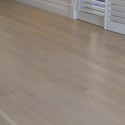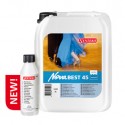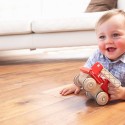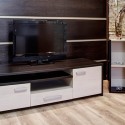The information listed below deals with the impact of coating timber floors in winter when the ambient air temperature drops, commonly known as coating in cool weather. The cold weather does not discriminate between any types of coating.
In winter periods, when the air temperature drops below 15 degC, this will have a significant negative effect on the application of the coating and most importantly its performance. For example the coating will not flow and level properly and the surface will mark very easily. When air temperature drops even further, say below 10 deg C, this will have an even more severe negative effect on both the coatings application and performance.
If one reads any coating manufacturers technical data sheets there will always be a technical reference to what the optimum temperature conditions need to be for successfully coating application in addition to conditions allowing it to dry and cure correctly. The most common floor temperature range referred to is between 15 degC and 23 degC.
One must also bear in mind that the physical floor temperature in a house will be much lower than the surrounding air temperature. When one applies a wet coating, in winter, over a timber floor that is already cold, the surface temperature will drop even further resulting in an even slower rate of drying and curing as the solvents start to evaporate. In addition dampness and humidity will also slow down the drying and subsequently the curing process of the floor coating.
The problems that occur in winter for Solvent based, Water based and Oil type finishes are:
Viscosity increases. This means that the coating becomes thicker
This is will result in: Poor flow and levelling, the coat will not want to level out causing;
- Orange peel
- Application marks from roller on side and stop marks
- Quilting
- Increased risk of rejection
Increased Surface Tension. This means the coating loses its ability to flow over another surface.
This will result in: Poor flow and levelling resulting in;
- Orange peel
- Build up at board edges
- Pitting
- Application marks from roller on side and stop marks
- Quilting
- Increased risk of Rejection
Cure Rate slows. This means that coating is not cured throughout the thickness of the film.
This will result in: Coating being “green” for longer causing;
- Full cure can take weeks and made worse when additional coats are applied over an uncured coat.
- Slower solvent release requiring extended dry and curing time
- Delamination of subsequent coats especially water base finishes
- Swirl marks/cob web from screen baks when screening back
- Clogging up of abrasives
- Finish coat will scratch and scuff VERY easily
- Contrary to common belief water based finishes are equally as sensitive to the above problems as solvent finishes.
- The Dry/Cure rate will be MUCH slower on water based finishes
Slow solvent release. This means the coat will stay wet for longer time.
This will result in: Longer open coat time resulting in;
- Extended dry and significant curing time required
- More time required for solvents to evaporate
- Premature re-coating will result in delamination
- Longer open coat allows dust to settle in coating
- Greater chance of rejection with oily timbers such as Spotted gum and extractives from Brush Box causing problems.
- Hazy surface appearance
- More chance of “Ghosting”.
- Inconsistent gloss levels especially with polyurethane coatings
Coating below dew point. This is when the temperature drops below dew point. Say in the afternoon when evening temperature starts to drop.
This will result in: water base finishes not drying and inconsistency in solvent finishes gloss levels.
- Water base finishes not drying and hence not curing
- Water base finishes drying in a “ white” crystalized fashion
- Cracking of the film
- Gloss solvent finishes dry inconsistently and dull
- Satin solvent finishes dry inconsistently and shiny.
In Winter time to minimise the above problems one needs to attend to factors that will influence the dry and curing times:
- The major factor that will contribute to drying and curing of the coating is VIGOROUS air movement and circulation over the drying surface. This will remove the solvent and water evaporation air layer above the coating. Enclosed rooms or windows cracked open will not increase the air circulation. One needs to have large fans to circulate fresh air as “dead air” stops the coating from drying and curing. After the coating is applied allowing for an initial settlement period, the area must be ventilated. Poor ventilation after each coat is applied will reduce the drying and subsequent curing allowing the coating to scratch and prematurely wear very easily.
- Increasing the air temperature of the floor and surrounding area before coating (warm up the room). This will reduce coating application problems and keeping the area warm after coating, will minimise the drying and curing problems. Also schedule the coating in the warmer part of the day. Avoid coating early in the morning or late in the day.
- Always store the coating container at normal room temperature during winter (in a warm place). Do not store coating cans in the van or on a concrete floor overnight. Acclimatise the coating to the room temperature, before using it, so that it can flow properly ,avoid bubbles and minimise rejection .
- As coatings dry from the top down. The solvents need to escape through the top film surface. As the film coat dries these solvents will takes longer to escape. Each time a new coat is applied over a previous coat that is not fully dried and cured, the trapped solvents will take longer to escape. That means the curing of the coating will be slower, the coating will stay soft longer, resulting in more surface scratches and marring of the top coat.
- Always take note of the environment that one is working in as this will dictate how the coating will behave.
- Allow for longer curing periods between each coat. For example applying only one coat a day and even skipping a day between coats is advisable.
Summary of factors influencing drying and curing:
- Air circulation
- Temperature
- Storage
- Film thickness
- Relative humidity/ Environment




